Our cabin campout at Lamington proved to be a good place to watch wildlife without actually moving. In fact, it was difficult to get around without tripping over Australian Brush Turkeys (Alectura lathami) - well, OK, that's a slight exaggeration, but only a slight one.
At mealtime they were definitely all but underfoot.
When they weren't stalking about the campground looking for likely morsels, we could easily find them sacked out for a sunbathe on the nearby lawn.
Dinnertime was usually too late for the Brush Turkeys, but just right for this curious Common Brushtail Possum (Trichosurus vulpecula) - the same animal that has, with our help, made an utter nuisance of itself in New Zealand. We shipped it there in the mistaken belief that it would support a local fur industry. In the event, so much money has been spent trying to eradicate the New Zealand possums that it is hard to believe that it took several introduction attempts to get them established in the first place.
Other visitors to the campground were more interested in the surrounding trees, and what they had to offer, than in anything we humans might be doing. The clear highlight, for me, was a bird that flew in right over our dinner table on our last morning: a female (or perhaps a young male) Paradise Riflebird (Ptiloris paradiseus), most southerly of the birds of paradise.
The female may lack the velvety black plumage and iridescent blue-green breast shield the adult male acquires after perhaps as long as seven years (I was lucky enough to see a male bird earlier in the forest, but not lucky enough to photograph it), but she is an interesting creature all the same.
The tremendous range of display plumages in the birds of paradise has diverted attention from another radiation in this remarkable family - their variation in bill shape and feeding habits. While many birds of paradise are short-billed fruit-eaters, riflebirds have particularly long, almost curlew-like bills and act rather like giant treecreepers, hunting for their insect food on moss-covered tree limbs. That's what our bird proceeded to do, and it stayed with us, doing it, for quite some time - much to my delight.
For other birds I had to stretch my legs a bit - though, often, not for long. I could hear the squawks of the spectacular Yellow-tailed Black Cockatoo (Calyptorhynchus funereus) from our cabin door, and after only a bit of a chase caught up with them feeding and preening in a nearby tree.
Other birds I found at the forest edge included Lewin's Honeyeater (Meliphaga lewinii)....
... Several attractive Eastern Yellow Robins (Eopsaltria australis), relatives of the New Zealand robins and tomtits - once familiar garden birds, but
now hard to find in urban Sydney at least...
... And a little group of Red-browed Finches (Neochmia temporalis).
Some other birds I only found along the forest trails (not including, unfortunately, my 'target' bird at Lamington, the shy and elusive Rufous Scrub-Bird (Atrichornis rufescens), a creature I also missed in 1972). Two species of scrubwren were common in the undergrowth, the Yellow-throated (Sericornis citreogularis) and the more abundant and widespread White-browed Scrubwren (S. frontalis), the bird in these photos.
From high above me in the forest canopy I could occasionally hear a wailing sound, like the complaint of a cat being slowly strangled. It took a local birding guide I met on the trail to identify it as the voice of the Green Catbird (Ailuroedus crassirostris), and with a little effort I finally got a (poor and distant) shot of it. The Green Catbird is a bowerbird (of which more below), but unlike most other members of its utterly remarkable family it is monogamous, and does not build a bower. Instead, males are content to woo their females (and their females to accept them) on a cleared display ground, decorated with leaves, on the forest floor.
Even more peculiar, perhaps, than the catbird was another bird I met several times in the darker patches along the forest trails. The Australian Logrunner (Orthonyx temminckii) is a member of a tiny family, with only three (or just possibly four) living species, that lies somewhere near the root of the oscine (that is, 'true' songbird) family tree.
It is an odd creature. It has weak, rounded wings and seldom flies. Unlike most songbirds, the female is the more colourful gender (these are males; she has a bright orange-rufous breast) - admittedly, the birds may not see it that way, as the female still has the job of building her nest and raising her young on her own, though the male brings her food to pass on to her offspring. Logrunners have spine-tipped tails used, unusually among birds, to brace themselves against the ground while they scratch through the leaf litter.
Unlike its birds and mammals, Australia's butterfly fauna is, by and large, very similar to that of Southeast Asia. The Common Crow (Euploea core) is not a bird, but a butterfly - one of the Danaiinae - and a common species from India to Australia.
The most famous of the Danaiinae, the Monarch (Danaus plexippus), lives in Australia too, though here it is usually called the Wanderer. Strangely enough, it is not found in continental Asia; instead, it seems to be a recent arrival in Australasia, first noted in Australia around in 1871 or so. It seems that it success here dates from the introduction of milkweed, it's food plant. Perhaps migrant Monarchs regularly found themselves blown across the Pacific for centuries before, but without milkweed their caterpillars would have had nothing to eat.
After dark, the mammals came out to the lawns below the lodge, and Alicia and I went out in search of them, flashlights in hand - not just the possum that prowled around our campsite, but Long-nosed Bandicoots (Perameles nasuta) and Red-necked Padamelons (Thylogale thetis) like this one - shy, smallish, nocturnal forest wallabies.
My wife Eileen, though she has many sterling qualities, is not, I fear, a birder. However, there was one bird-related object that she very much did want to see in Australia, ever since viewing David Attenborough's splendid documentary on its maker and his relatives. Lamington gave me my best chance to show her one, so when we arrived at Binna Burra almost the first thing I did was to ask a local naturalist if he knew where I might find the bower of a Satin Bowerbird (Ptilonorhynchus violaceus). He did indeed - there was an active bower at the foot of the lodge driveway, only a few yards from where we had parked our car!
In case anyone out there is not familiar either with the bird or its remarkable creation, this is not a nest. It is a display structure built, managed and decorated entirely by the male in the hope of convincing a female bowerbird that he can provide her with suitable genetic material. The Satin Bowerbird is one of the "avenue builders", who construct a bower consisting of two parallel walls in the centre of a mat of straw and other carefully selected materials. He is particularly fond of the color blue – the color of his eye – and prefers to decorate his bower with blue objects: feathers, bits of plastic, bottle caps or what you will. He even paints the inner walls of the bower with the juice of blue berries crushed in his beak. Competition between males for the attention of a female is intense, and older bower birds regularly destroy the bowers of their younger rivals.
I well remember how thrilled I was to actually see one of these structures on my first visit to Australia in 1969. I have seen many since, but to find one here, literally cutting edge of the parking lot – and, particularly, to be able to show it to Eileen – was one of the high points of our visit to Lamington.


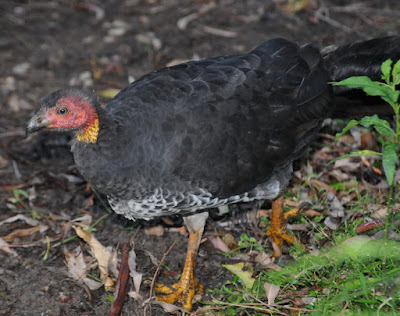



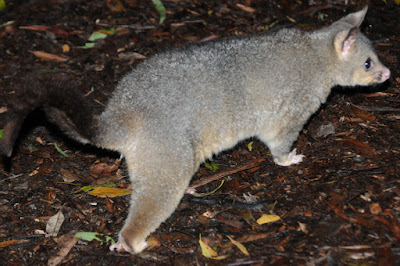




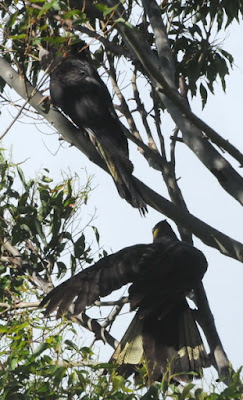






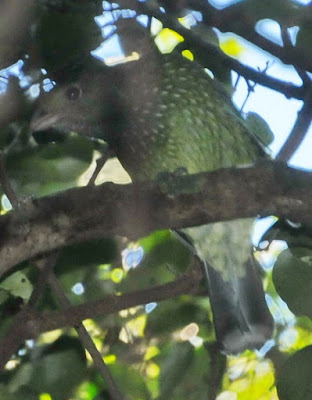

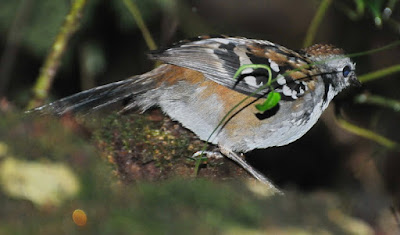






No comments:
Post a Comment